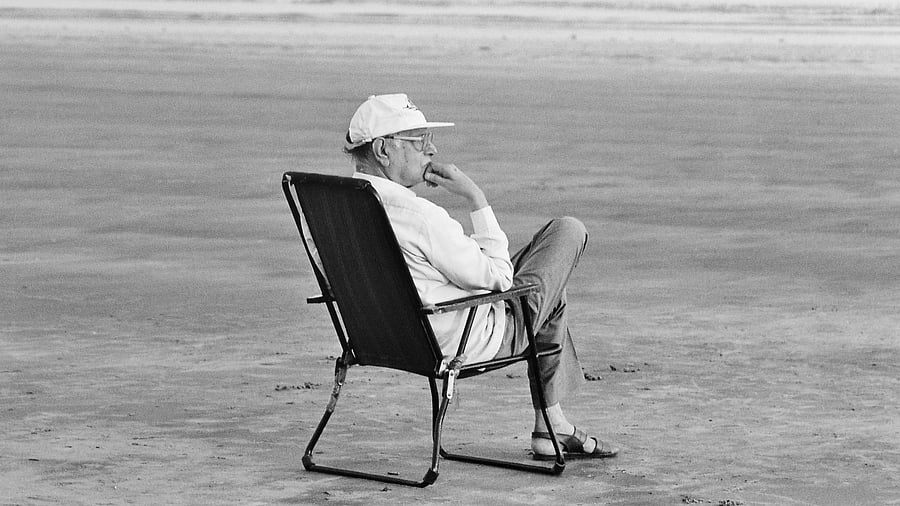
Tapan Sinha during a shooting break of ‘Ek Doctor ki Maut’.
Credit: Sukumar Roy
In July 2008, Tapan Sinha, recipient of 19 National Awards in various categories, was conferred with the Dadasaheb Phalke Award for the year 2006. It was the second national honour for the 84-year-old filmmaker who was presented with the ‘One Time Award for Lifetime Achievement’ to commemorate 60 years of India’s Independence in June the same year. While Sinha was happy, as he pointed out to me on a call, he was content with all that he had achieved, and just wanted to relax now. He was recuperating following a heart ailment.
Five months later, he passed away. I was as bereft as Mini watching her friend being led away by the police in his 1957 adaptation of Rabindranath Tagore’s ‘Kabuliwala’. While many remember Balraj Sahani as the Afghan trader who befriends the five-year-old Bengali moppet from the 1961 Hindi film, for me Kabuliwala will always be Chhabi Biswas (from Sinha’s adaptation).
Amitava Nag, author of The Cinema of Tapan Sinha, shares that the filmmaker had a harrowing time making the film which won two National Awards for Best Feature Film and Best Feature Film in Bengali, along with the Silver Bear Extraordinary Prize of the Jury at the Berlin International Film Festival. This was not just because Visva-Bharati University took its time agreeing to the changes he had incorporated in the original story, but also because, for his lead actor, the poor Kabuliwala was an unfamiliar character.
“Chhabi Biswas couldn’t understand why this young, three-film-old director wouldn’t let him wear expensive silk and zari costumes and theatrical make-up. He even wanted him to tone down his histrionics to a more natural style of acting,” informs Nag, admitting that though the legendary actor eventually got the drift, he also got away doing a few scenes his way.
“During a shoot in Kashmir, for a long shot of Rahmat travelling in a caravan, he got Tapan Sinha’s assistant Balai Sen, who was similar in height and build, to stand in for him since there would be no close-ups,” Nag laughs. He adds that in the 1960 Bengali film ‘Kshudhita Pashan’, another Tagore adaptation, Biswas was more amiable, having seen how ‘Kabuliwala’ had made him not just a national, but also an internationally acclaimed actor. Ray’s ‘Jalsaghar’ starring Biswas had released the year before. Interestingly, when Sinha’s art director couldn’t grasp his instructions on the mansion set for ‘Kshudita Pashan’, Ray drew it for him, emphasising the play of light and shade on the architecture and underlining the bonding between the two filmmakers.
Actor Prosenjit Chatterjee shares that Sinha worked like a European director. The influence perhaps came from assisting Jean Renoir when he was filming ‘The River’ (1951) in Kolkata and his subsequent tenure with London’s Pinewood Studio. “Tapan jethu would start shooting at 10 am sharp and pack up by 5 pm so he could go play golf. You couldn’t be late for his shoots because each shot was precisely planned for a particular time of the day,” shares Bengal’s matinee idol.
He fondly recalls that for the 1986 film ‘Atanka’, they had several workshops before the shoot. Sinha himself would read out scenes with Satabdi Roy and him since they were relative newcomers, instructing them on how to act and react.
While making the Bengali film ‘Hatey Bazarey’, Vyjayanthimala insisted on singing ‘Cheye thaki’ with Mrinal Chakraborty. Since she was struggling with the language, Sinha had someone record the song and sent her the spool so she could practise. “She performed it really well on screen. Amol Palekar too was brilliant in the 1984 telefilm ‘Aadmi Aur Aurat’. I remember he was unhappy with a particular shot and had requested a retake. Tapan Sinha insisted it was fine and a stressed Amol couldn’t sleep that night. To his surprise, the next morning, his empathetic director, realising this, told him he could give the shot again,” recounts Nag. He points out that this actor’s director was also a writer, composer, singer and could have been an actor himself. “None of his films ever went over-budget and he always ensured his crew got paid the same day,” he adds.
The Padma Shri awardee made some great films. ‘Jhinder Bondi’, an adaptation of the 1894 novel ‘The Prisoner of Zenda’, ‘Atithi’, based on Tagore’s short story, ‘Golpo Holeo Satti’, the courtroom drama ‘Adalat O Ekti Meye’ which is undoubtedly Tanuja’s best performance and Pankaj Kapoor and Shabana Azmi’s ‘Ek Doctor Ki Maut’, loosely based on Dr Subhash Mukhopadhyay who pioneered in vitro fertilization. ‘Golpo Holeo Satti’ was remade in Hindi as ‘Bawarchi’ and ‘Apanjan’ as ‘Mere Apne’. Perhaps his most important film was the 1970 period political drama, ‘Sagina Mahoto’, with Dilip Kumar as a labourer in a factory in Siliguri, who after fighting the tyranny of his British bosses in the tea gardens, is tried and sentenced by the communists who had befriended him and made him a trade union leader.
“Tapan Sinha who was not a leftist expressed his growing discontent with Bengal’s politics through this film, and by opting for Dilip Kumar, he cleverly extended its reach. While its 1974 Hindi version ‘Sagina’ may not have worked commercially, he was able to bring the hypocrisy of the communist movement into the mainstream,” says Nag. Sinha’s anti-government stance may have led to exhibition problems and deprived him of tax-free benefits, but the filmmaker became more angry, politically agitated and socially committed with age, which is perhaps why in his centenary year, his films still seem as contemporary and topical in the issues they showcased.
When I had asked Sinha his favourite film, he had picked the 1959 black-and-white Bengali film Khaniker Atithi. “It moved Mrinal Sen to tears. Even Satyajit Ray complimented me for the film,” he had stated. And that sums up the genius of Tapan Sinha.